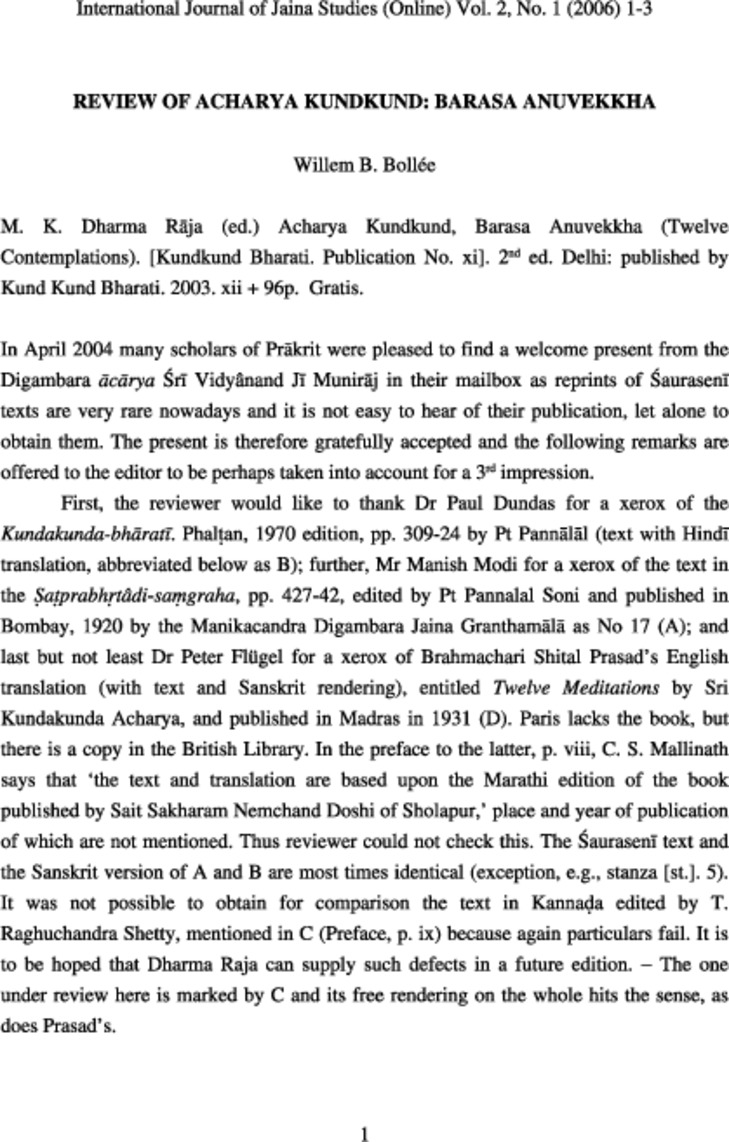
International Journal of Jaina Studies
(Online) Vol. 2, No. 1 (2006) 1-3
Abstract
The review of Kundkund’s book Barasa Anuvekkha (Twelve Contemplations) deals with a free reprint of a Śaurasenī text which is a rarity. The reviewer’s remarks aim at providing some material for a new edition.Review Of Acharya Kundkund: Barasa Anuvekkha
M. K. Dharma Rāja (ed.) Acharya Kundkund, Barasa Anuvekkha (Twelve Contemplations). [Kundkund Bharati. Publication No. xi]. 2nd ed. Delhi: published by Kund Kund Bharati. 2003. xii + 96p. Gratis.
In April 2004 many scholars of Prākrit were pleased to find a welcome present from the Digambara ācārya Śrī Vidyânand Jī Munirāj in their mailbox as reprints of Śaurasenī texts are very rare nowadays and it is not easy to hear of their publication, let alone to obtain them. The present is therefore gratefully accepted and the following remarks are offered to the editor to be perhaps taken into account for a 3rd impression.
First, the reviewer would like to thank Dr Paul Dundas for a xerox of the Kundakunda-bhāratī. Phalṭan, 1970 edition, pp. 309-24 by Pt Pannālāl (text with Hindī translation, abbreviated below as B); further, Mr Manish Modi for a xerox of the text in the Ṣaṭprabhṛtâdi-saṃgraha, pp. 427-42, edited by Pt Pannalal Soni and published in Bombay, 1920 by the Manikacandra Digambara Jaina Granthamālā as No 17 (A); and last but not least Dr Peter Flügel for a xerox of Brahmachari Shital Prasad's English translation (with text and Sanskrit rendering), entitled Twelve Meditations by Sri Kundakunda Acharya, and published in Madras in 1931 (D). Paris lacks the book, but there is a copy in the British Library. In the preface to the latter, p. viii, C. S. Mallinath says that 'the text and translation are based upon the Marathi edition of the book published by Sait Sakharam Nemchand Doshi of Sholapur,' place and year of publication of which are not mentioned. Thus reviewer could not check this. The Śaurasenī text and the Sanskrit version of A and B are most times identical (exception, e.g., stanza [st.]. 5). It was not possible to obtain for comparison the text in Kannaḍa edited by T. Raghuchandra Shetty, mentioned in C (Preface, p. ix) because again particulars fail. It is to be hoped that Dharma Raja can supply such defects in a future edition. − The one under review here is marked by C and its free rendering on the whole hits the sense, as does Prasad's.
St. 5: even Dr Sangave who undertook "the painstaking effort of overseeing the manuscript" (Preface, p. ix) apparently oversaw a corruption shown by the metre: jala-bubbuda-Sakka-dhaṇū-khaṇa-ruci-ghaṇa-soha-m-iva thiraṃ na have. Even the status of celestials, it is said, is not everlasting: "these are similar to the water-bubble, the flash of the lightning and the splendour of the rainbow." The translation in D runs: "water-bubble, rainbow, lightning and magnificence of clouds." The beginning of the bpāda is corrupt and the translations pass over the difficulty which ought to have been discussed in a note. Khaṇa is sanskritized as kṣaṇa. − Restoring the metre reviewer proposes to read ruci-ghaṇa-rava-soha- and to render: "water-bubble, splendour of the rainbow and thunder-and-lightning.' The akṣaras: kha and rava are very similar, of course. D reads: vivihehiṃ, sanskritized as vividhaiḥ.
St. 7 devâsura-maṇu(v)a-rāya-vihavehiṃ | vadiritto so appā must mean 'the soul is different from the splendour of gods, demons and human kings', not: "humans and the kings". The translation in D runs as: ".... it should always be contemplated that the soul is distinct from the riches of the lords of devas, asuras and human kings and that it is everlasting." − Cf. vs 3.
St. 8 contains a misprint; read: maraṇa-samayamhi with ABD.
St. 10, where ABD wrongly read pecchanto, has a corrupt word kaddie before kāle, sanskritized in AD as kardite, which makes no sense. One could think of kandiya ~ Sa. krandita 'lamented, deplorable': 'when the lamented death looks at him.'
St. 11d bandhôdaya-satta-kamma-vadiritto is probably -śakta-karma-vyatirikto in Sanskrit instead of -sattva-k° in ABD and perhaps also in C. I would translate the pāda as: (the soul) 'when it is without karma bound by the emergence of bonds / by emergent bonds.'
St. 12ab must read: aruhā siddhâyariyā uvajhāyā sāhu panca paramêṭṭhī. ABC read siddhāiriyā, C reads: uvajjhāyā, D reads: siddhā āiriyā.
St. 16c probably read: deva-maṇuvesu jīvo in order to restore the metre.
St. 20 is a śloka and therefore must be a quotation.
St. 24 instead of "Entanglement in.... cycles of existence replete with birth, senility, death, disease and fear is the lot of the soul" perhaps '.... replete with fear of birth....' (Saṃsāre jādi-jarā-maraṇa-roga-bhaya-paure) is meant.
St. 28 for uparittaṇā read with B uvarillayā. AD have uvarillavā corrected to uvarillagā.
St. 32c for kuḍḍiya-dhamma-kulingaṃ ABD read: kudhamma-kulinga-kutitthaṃ which does not fit the metre and seems to be an explanation of kuḍḍiya.
St. 34b ABD read: ca aha-ṇisaṃ.
St. 37d read with ABD: niccaya-ṇaya-kamma-ṇimmukko for niccaya-ṇayeṇa k°.
St. 38b and d: AB read vicintejjo, D: -ijjo corresponding to jīvo which seems better than vicintejja of C sanskritised in A as vicintanīyaṃ.
St. 41d AB read: ṇāma uḍu-ādi tesaṭṭhī, D reads: -tesaṭṭī for the unmetrical ṇāma uḍḍha-ādi t° of C, and see W. Kirfel, Kosmographie der Inder. Bonn / Leipzig, 1920: 3 ch. 3D (p. 292f.).
St. 43d read with ABD: cokkhaṃ
St. 45b ABD correctly add, but C omits: -kimi- between pūya and bahulaṃ; B wrongly reads putta for mutta. If majja is deleted, the āryā is perfect (thus Professor A. Mette, p.c.):
Rasa-ruhira-maṃsa-med'-aṭṭhi-[majja]-saṃkulaṃ mutta-pūya-kimi-bahulaṃ |
St. 47b read with ABD: honti. St. 49b ABD read vi ya for idi.St. 52b read: hassa against ABCD hāssa.
St. 61d read with AB: tti; D: ti. St. 62d palagehiṃ metrī causā for ABD pallagehiṃ. St. 69d read: desa-virad' ede with ABD against C: desa-virade ya.St. 70 for ABCD uttama-khama-maddav'-ajjava-sacca-sauccaṃ ca saṃjamaṃ c'eva read perhaps, in order to restore the metre: -maddava-sacc'-ajjava-soccaṃ ca .....
St. 72d delete with ABD: vi at the end.
St. 80d ABD read: sukkadi... dharadi
St. 81b ABD read: hu for C: du.
St. 87a read: bārasa-aṇuvekkhāo with ABD.
St. 88c read with ABD: pakuvvadi for C: prakuvvadi.
St. 89b read with ABD: aṇuvekkhaṃ.© The Editor. International Journal of Jaina Studies 2006
 Prof. Dr. Willem Bollée
Prof. Dr. Willem Bollée
